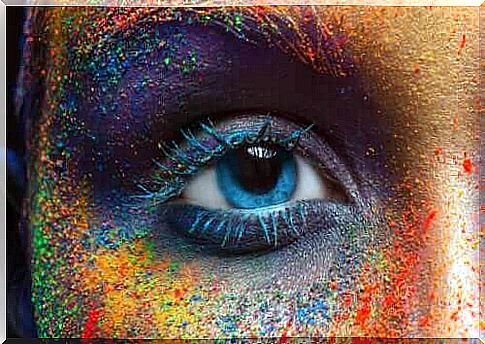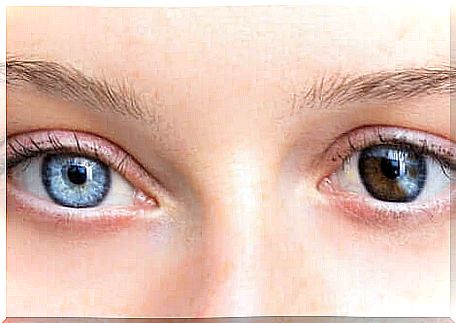Eyes That Change Color: Truths And Myths

Eye color, just like skin and hair color, is related to the individual’s melanin production. Some people experience that their eyes change color during life for various reasons. In this article, we will clarify some of the myths surrounding this topic.
There are more than 150 genes involved in the production, transport and storage of melanin. Melanin is what gives pigment and ultimately defines the color of a person’s eyes.
People who have bright eyes in the blue-green area do not produce or store large amounts of melanin. On the other hand, they do this with darker eyes, everything from dark brown to black.
How is the eye color determined?
According to an article published in the journal Missouri Medicine , human eye color is determined by the density and size of melanocytes, which are the cellular structures that make melanin. Melanocytes are all over the iris stroma and affect the color and tone of the eyes.
The above article also explains that the OCA2 gene on the 15th chromosome produces the protein that is responsible for creating and treating melanin. The more active this gene is, the more melanin it produces, resulting in darker eye colors. However, there are other genes that can affect eye color, and several of them involve lighter colors such as blue and green.
What does the iris do?
The iris is a flat, annular membrane made of connective tissue and muscle fibers. It lies behind the cornea and surrounds the pupil. The iris is the part of the eye that has color and, along with the pupil, controls how much light enters the eye.
The muscle fibers in the iris help to expand and shrink the pupil so that light enters the eye. When it works properly, this function occurs naturally in response to the amount of light in the environment.
According to the American Academy of Ophthalmology, it can sometimes seem as if your eyes change color, but more often than not, it’s just a trick the light plays. Changes in light cause the pupil to dilate, which can also make it look as if your eyes have a different color. This is only temporary.
However, if you notice an obvious change in eye color, in one or both eyes, you should contact an optician immediately. Eyes that change color are actually quite rare and can be a sign of illness such as uveitis, hepatitis or aniridia from medications or eye trauma.

Common belief about eyes changing color
There are many perceptions about how and why the eyes can change color. We are here to help you identify which are true and which are myths.
Eyes that change color: We are born with a different eye color
This is correct. During the first months of life, melanocytes have just begun and have not produced whole body melanin. Therefore, the eye color of a newborn is likely to change continuously over time.
An article published in the American Academy of Pediatrics points out that melanocytes need about a year to produce all the melanin in your body. In other words, your baby’s gray or blue eyes may darken during the first year of life.
It is possible that some babies are born with conditions that affect pigmentation, such as albinism or heterochromia, in which case one eye may be different from the other, or one eye may contain many different colors. Accidents, genetic factors or illness can all cause this condition.
Green eyes are the result of a genetic mutation
False. Green eyes are not the result of a genetic mutation, but rather the result of moderate melanin production and a medium density of melanocytes, as suggested by this article in News Medical.
An article published in the International Journal of Molecular Sciences suggested that eye color is not determined by the number of melanocytes. Instead, according to the study, it is the melanin composition that affects the eye color. There are three types of melanin: eumelanin, feomelanin and neuromelanin. Only feomelanin affects eye color.
Eye color can change with your mood
False. Your mood does not change eye color, or at least there are no studies that support this claim.
As we mentioned earlier, changes in light make the pupil dilated to adapt to the lighter or darker environment. When this happens, less of the iris is visible, which may trick you into thinking that your eye has a different color. In addition, your eyes may even reflect the color of a nearby object, which is attributed to this misunderstanding.
There are surgeries that change the color of your eyes
This is true, but we do not recommend it. In addition to wearing colored contact lenses, there are two surgeries that can change the appearance of the iris. One of these is a prosthetic iris implant. The first Norwegian patient underwent artificial iris surgery in 2013, and today these operations are performed at several hospitals in Norway.
This type of surgery began as a way to treat birth defects and fix the eye after an accident. However, it quickly became a popular cosmetic procedure.
Most medical professionals will advise against exposing healthy eyes to this surgery, as it can compromise proper eye function if something goes wrong. Some of the risks of this surgery are an increase in intraocular pressure, intraocular swelling, corneal edema, loss of vision and glaucoma.
The second type of surgery is keratopigmentation of the cornea, better known as corneal tattoo. This procedure is for patients with varying degrees of blindness that cause opaque spots in the eye.
Corneal tattoos help to reduce the appearance of the affected eye while posing few risks, making it a great option for treatment and cosmetics. For people who want to use this technique for cosmetic purposes, a clinical study evaluating the long-term effects of the procedure found that it can cause photosensitivity, discoloration of the eye and keratitis.

Take care of your eyes
Our eyes help us to take in the world around us and perform daily activities without problems. In fact, sight is considered the most dominant of the five senses. Although you may not like your eye color, it is important to remember that these procedures can cause irreparable damage to your eyes and eyesight.
After the first year of life, the eyes usually retain the same color. If you notice changes in your eye color, visit an optician. They will help you understand why the changes happened and what you can do to keep your eyes healthy.









